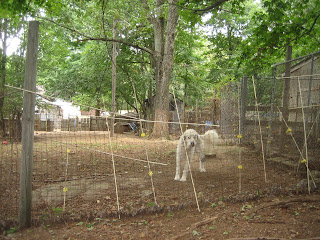





Now that I am (safely) back from almost two weeks of air (and other) travel in Europe to speak at conferences, I can reflect on my observations regarding airport security (or lack thereof).
As an academic, I speak at conferences frequently, and especially, as a female, I believe that it is very important to, when asked, to accept invitations to give plenary talks. Such invitations brought me recently to the
2010 Computational Management Science conference in Vienna, Austria and to the
Yalta Optimization Conference in the Crimea, Ukraine.
I was traveling to these conferences alone.
What struck me in a dramatic fashion was the different levels of airport security. My journey began on July 26, 2010, when I flew out of Logan airport in Boston and I flew on a total of 8 different flights over the subsequent 12 days, getting back to Boston on August 5 (and landing just before a major thunderstorm hit the area).
I conduct research in operations, with a focus on transportation, logistics, and network systems, and have a special interest in risk management and safety and security issues.
The airport security at Logan was, as one would expect, visible and thorough, and all air travelers had to remove their shoes, jackets, etc., while passing through security, and to have their liquids in plastic quart bags. My journey took me through the Frankfurt airport (en route to Vienna and then back from Vienna to Boston after my conference in Ukraine). Strangely enough, passengers did not need to remove their shoes (which is standard in every airport that I have flown through in the US in the past several years) when going through security at the Frankfurt airport but we did have to have the liquids that we were carrying through security in appropriately-sized plastic bags.
After my conference in Vienna (please see my earlier blogposts with photos on this great experience) I flew to the Simferopol airport, which is in the Crimea, Ukraine, through Kiev, the capital of Ukraine. My flights in Ukraine were on Ukraine International Airlines, and they were, unexpectedly, very comfortable and delightful.
The Yalta conference was a fascinating experience scientifically, culturally, and also personally, since this was my first trip to Ukraine, the country of the birthplace of my parents (and Ukrainian is my first language with Russian being my fifth).
Landing at the Simferopol airport, we disembarked under the skies, which were turning to dusk to a welcoming by a sea of taxi drivers (
you can read about my driver "Igor" here). I urge all passengers to use the facilities of your airplane before disembarking your plane here since the restroom facilities are shocking (see bottom photo above). Not only is handicap-accessibility unknown but one has to lug the suitcases down slippery steps and then go up and down and then up again to reach a stall (with small wooden door) featured above. Yes, folks, I had nightmares after this travel experience and I have been to many countries.
After the conference in Yalta, on August 4, 2010, I was back at the Simferopol airport to take my flight to Kiev and then onwards to Vienna before I would begin my journey back to Boston via Frankfurt.
The almost gingerbread-looking house above is the terminal for intra-Ukraine flights. The landscaping, also featured above, is rather delightful. I noticed two gentlemen walking towards this terminal who were clearly tourists and who I had overheard speaking German so I spoke to them and they also spoke English (English is my second language and German my fourth). They were on my flight (see them drinking coffee above in the tiny airport coffeeshop) and, coincidentally (despite our flight being not even 1/3 full), had received seats next to me (21A,B,C). Some weird assignment algorithm must have been used for our seat allocation (or, perhaps, the gate agent just thought we were traveling together although we checked in separately).
Now for the punchline, at security at the Simferopol airport, not only did we not have to remove our shoes, we did not have to remove our plastic bags with liquids, AND we were all carrying large plastic bottles of water since it was so hot! Once the three of us passed the so-called security, we looked at one another with wide eyes. One of the Germans remarked that he was praying that the plane would not blow up. He was a physicist and even made sure on our flight that folks had their electronic equipment turned off upon takeoff and landing.
Waiting to board we were filled with anxiety and the plane (a Boeing) taxied for 15 minutes on a jetway with cracks and grass growing through. One of my new "friends" commented that if we were to have an emergency landing that it would be softened by the grass. Nothing like humor and jokes to alleviate some of the tension. We promised to all hold hands in the case of a "crash" landing.
Well, we made it to Kiev, transfered to the international terminal, whose main feature was the Irish Pub, and we hung out together until they were off on towards Dusseldorf and I was off to Vienna. My overnight at the NH hotel by the Vienna airport was heavenly and, if I am ever stuck, for some reason, at the Vienna airport, where you certainly can't starve, I will definitely stay at this terrific business hotel.
 Zac Bissonnette, who is a senior at UMass Amherst, was interviewed by Ann Curry on the Today Show. The interview is worth watching for several reasons:
Zac Bissonnette, who is a senior at UMass Amherst, was interviewed by Ann Curry on the Today Show. The interview is worth watching for several reasons:






































































